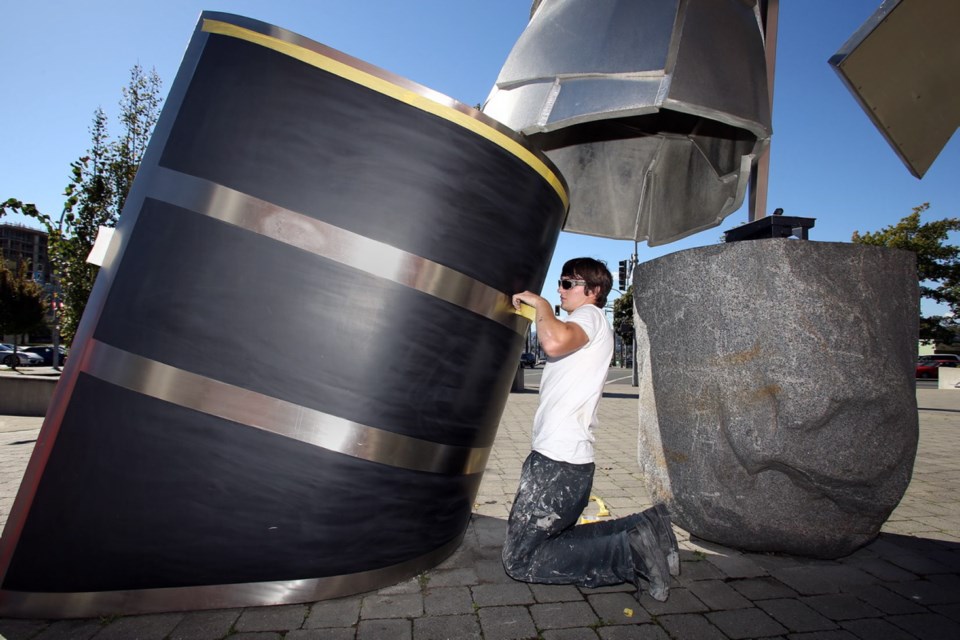 Elizabeth May had a bit of a pointed fun on the weekend. The Green Party leader stood on a rocky Nova Scotia headland and posed for a photo: shawl over her head, arms stretched toward the sea, just like the monolithic, controversial Mother Canada statue proposed for the spot.
Elizabeth May had a bit of a pointed fun on the weekend. The Green Party leader stood on a rocky Nova Scotia headland and posed for a photo: shawl over her head, arms stretched toward the sea, just like the monolithic, controversial Mother Canada statue proposed for the spot.
Then she tweeted the photo: “Back from a break, at Green Cove in Cape Breton Highlands National Park. #MotherCanada nothanks. #realmothers4parks.”
May might be the MP for Saanich-Gulf Islands, but she spent much of her formative years on Cape Breton Island.
The idea of slapping a 24-metre-high statue in the wilds of a national park there gives her the willies. She’s not alone.
The Never Forgotten National Memorial Foundation wants to erect Mother Canada as the centrepiece of a multimillion-dollar memorial to Canada’s war dead.
It was billed as a private initiative, but we now hear the foundation not only got $90,000 from Parks Canada but is looking at tapping into a federal infrastructure fund set up to mark the 150th anniversary of Confederation in 2017.
With its gift shop, 300-car parking lot, “With Glowing Hearts National Sanctuary” and “Commemorative Ring of True Patriot Love,” the project has been labelled jingoistic Dollywood kitsch.
Mother Canada itself has been compared to a quasi-religious Virgin Mary dashboard figure and derided as a vulgar monstrosity more suited to Stalin’s Soviet Union.
Proponents play the patriotism card, but it’s not as if Canada is short of statuary marking its fallen.
Monuments exist from Vimy to the national memorial in Ottawa to right here in Victoria, which is dotted with half a dozen cenotaphs (not to mention Shelbourne Street’s magnificent London plane trees, planted in tribute to those killed in the First World War).
Being nothing if not petty and parochial, I’d like to argue that if the East Coast can get some giant jeezly statue in a national park, then we on the West Coast should get the same — perhaps a massive statue of a Big Oil executive reaching out toward the markets of China, or a pitchfork-wielding xenophobe jabbing at a refugee. They could erect it on Long Beach.
Or not. It always gets awkward when politics, ideology, public art and private tastes overlap. Witness the ongoing controversy over the Conservative-backed, privately financed plan to plunk a Victims of Communism monument across from the Supreme Court of Canada in Ottawa.
Likewise, not everyone in Victoria was thrilled in 2000 when the statue Spirit of the Republic was unveiled near the legislature, part of an NDP-backed, privately financed memorial to the Canadians who fought in the Spanish Civil War.
Even the Inner Harbour’s The Homecoming, a bronze sculpture of a child rushing up to greet a returning sailor, drew grumbling when it was unveiled five years ago to mark the 100th anniversary of the Royal Canadian Navy.
Nothing against the navy, the arguments went, but Victoria already had filled its quota of wholesome imagery.
“Does every piece of art on our sidewalks have to look like this?” asked a letter to the editor. “It’s as if we required movie theatres to show nothing but Snow White and the Little Mermaid, or bookstores to sell just romance novels and the Little House on the Prairies series. Makes my teeth hurt.”
The director of the Art Gallery of Greater Victoria chimed in with an op-ed in the TC: “Public art is a wonderful thing when done well and an embarrassment when it is not.”
Maybe they will feel better knowing that here and there on the Internet are scattered images of women interacting with The Homecoming, simultaneously pushing a hand into the bronze child’s face while leaning forward so the sailor’s outstretched hand is cupping a breast.
No piece of Victoria public art created as much of a brouhaha as Mowry Baden’s abstract sculpture Pavilion, Rock and Shell, unveiled outside Save-on-Foods Memorial Centre in 2003.
It took the threat of legal action to persuade city council, buried in outraged emails from citizens, to complete the $120,000 commission. One letter to the editor suggested that (as with Mother Canada) the problem wasn’t the artwork, but the appropriateness of its location.
The writer suggested moving it to the airport and renaming it Cessna, Rock and Fog.



